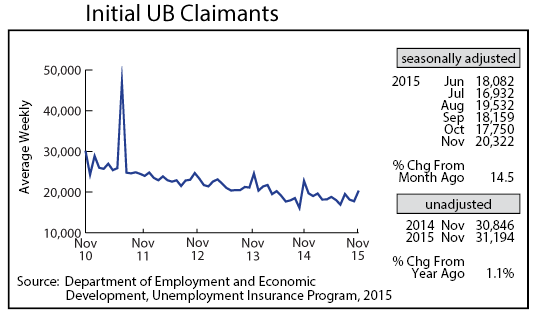by Dave Senf
December 2015
Note: All data except for Minnesota's PMI have been seasonally adjusted. See the feature article in the Minnesota Employment Review, May 2010, for more information on the Minnesota Index.
The Minnesota Index advanced 0.2 percent for the second month in a row in November, fueled by an uptick in wage and salary employment, a jump in average weekly manufacturing hours, and the third straight month of a declining unemployment rate. November's 3.5 percent seasonally adjusted unemployment rate is the lowest in over 14 years. The U.S. Index also climbed 0.2 percent.
The Minnesota Index, which is a proxy for economic growth in Minnesota, averaged 0.3 percent growth during the first quarter, 0.2 percent growth during the second quarter, and 0.1 percent growth during the third quarter. The 0.2 percent average increase over the last two months indicates that Minnesota's economy has regained some of its momentum that was lost during the middle of the year. Minnesota's index is up 2.4 percent from a year ago while the U.S. Index is up 3.1 over the same period. Minnesota's index has been increasing at a slower rate than the national index since December 2013.
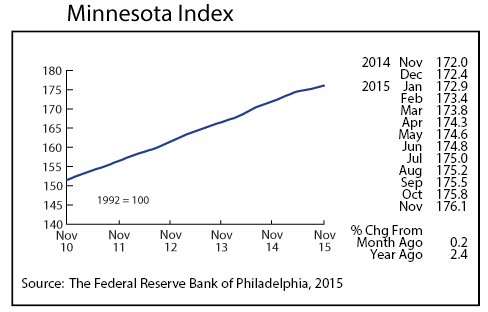
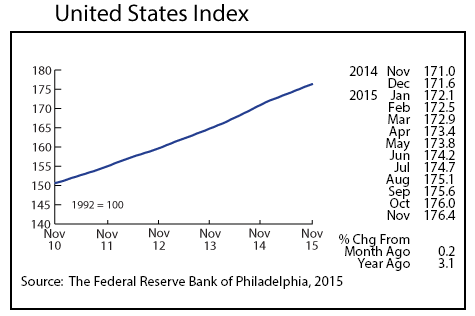
Adjusted Wage and Salary Employment increased by 7,200 jobs in November, the largest monthly job gain since May. Most of the payroll expansion occurred in the private sector which added 6,200 jobs. Eight of the 11 super sectors added jobs. The warm weather helped boost construction jobs by 3,300 jobs. Professional and Business Services, Leisure and Hospitality, and Trade, Transportation, and Utilities added the next most jobs. Local government hiring accounted for more than half the 1,000 job gain in the public sector.
Minnesota's unadjusted over-the-year job growth ticked up to 1.1 percent in November. Minnesota's annual average job growth looks to be headed to 1.4 percent for 2015, up slightly from 1.3 percent last year but significantly behind the U.S. rate for the second year in a row. Minnesota's 2015 job growth will likely lag behind Iowa (1.6 percent), South Dakota (1.7 percent), and Wisconsin (1.6 percent) but ahead of North Dakota (0.6 percent), at least until employment data is benchmarked in March next year. Iowa, South Dakota, and North Dakota all have unemployment rates below Minnesota so not all of Minnesota's slower job growth can be blamed on the state's tight labor market.
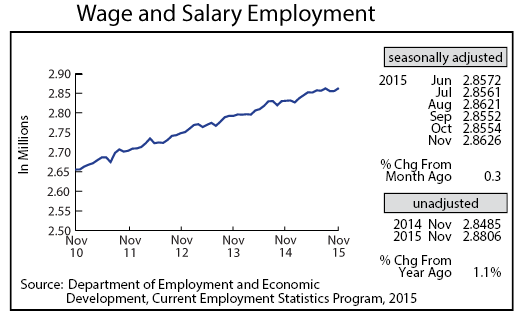
Minnesota's adjusted online Help-Wanted Ads skyrocketed to a record high of 142,400 in November. Online help-wanted postings increased 6.0 percent in Minnesota and 4.3 percent nationally. Minnesota's online help-wanted level is 12.6 percent higher than a year ago compared to 8.6 percent higher nationwide. This suggests that labor demand is higher in Minnesota than nationally and that Minnesota's slow job growth can be at least partially blamed on the state's tight labor market.
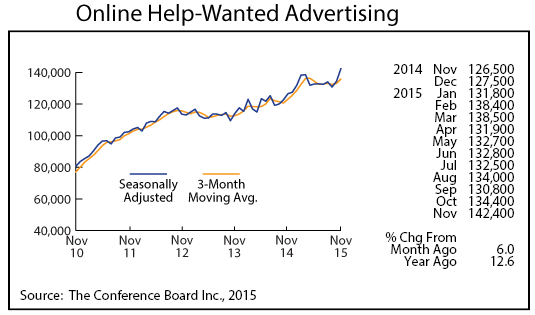
Minnesota's Purchasing Managers' Index (PMI) slipped further in November to 41.1, its lowest level since March 2009. The low reading indicates that Minnesota manufacturing activity has slowed as exports have waned, caused by a strong dollar and weak global economic growth. November's reading is the 18th lowest in the 10-year history of the index. All but three of the lower readings occurred during the 2001 or 2008-09 recessions.

Adjusted Manufacturing Hours rebounded partially in November, climbing to 40.4. The factory workweek, however, remains significantly lower than a year ago. Manufacturing hours last year set a 45-year record high averaging 41.7 hours per week. This year's average will be right around 40.5 hours which matches the 44-year average.
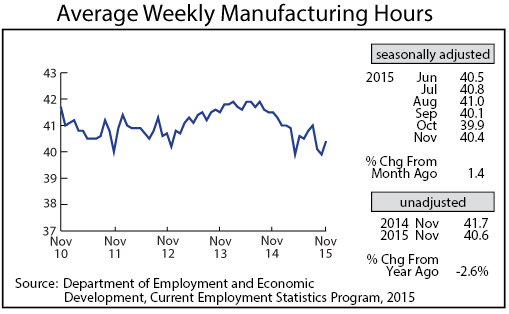
Manufacturing Earnings inched up for the second straight month in November to $825.14 but remain slightly lower in real terms than last year's factory paycheck.

Revisions to the Minnesota Leading Index were positive in November as the index now shows increases over the last six months, implying that economic activity in the state will be gaining strength over the next six months. This reading contradicts the direction of the state's economy predicted by the Minnesota PMI.
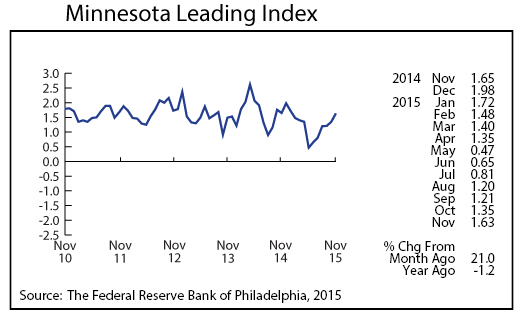
Adjusted Residential Building Permits dipped slightly to 1,794 in November but remained solid enough to indicate that Minnesota's home-building activity remains on its slow but steady path to recovery. Building permit numbers bottomed out in 2010 and have been slowly and unevenly rebounding since. November's 1,794 permits are 15 percent below the 45-year monthly average of 2,114.

Adjusted Initial Claims for Unemployment Benefits (UB) ramped up in November, topping 20,000 for the first time since last November. Initial claim levels, however, remain low, suggesting that the job growth will continue to hover in the 1.0 to 1.5 range.
